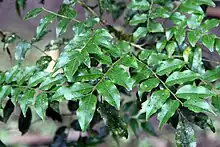Myroxylon peruiferum
Myroxylon peruiferum, or quina, is a species of tree in the family Fabaceae. It is native to tropical forests of North and South America.[1]
| Myroxylon peruiferum | |
|---|---|
 | |
| Scientific classification | |
| Kingdom: | Plantae |
| Clade: | Tracheophytes |
| Clade: | Angiosperms |
| Clade: | Eudicots |
| Clade: | Rosids |
| Order: | Fabales |
| Family: | Fabaceae |
| Subfamily: | Faboideae |
| Genus: | Myroxylon |
| Species: | M. peruiferum |
| Binomial name | |
| Myroxylon peruiferum L.f. | |
| Synonyms | |
| |
There is some historical documentation that could indicate this tree was the original species used to produce the fever remedy known as Peruvian Bark or Jesuit's Bark, which was synthesized by Jesuit missionaries in the 1600s from their observations of indigenous healers working with local flora. This remedy later became connected to the cinchona tree, also native to Peru, Ecuador and Bolivia, which produces quinine, a natural alkaloid that is effective against malaria. The two trees are not in the same taxonomic order or family.
Some contemporary resources do point to other traditional medicinal uses of Myroxylon peruiferum among communities who are familiar with the species.[2]
References
- Bagnatori, Ângela; Lewis, Gwilym P.; de Freitas, Vidal; Goulart, Ana Maria (2015). "A revision of the genus Myroxylon (Leguminosae: Papilionoideae)". Kew Bulletin. 70 (4): 48. doi:10.1007/s12225-015-9604-7. ISSN 0075-5974.
- Fern, Ken. "Useful Tropical Plants Database--Myroxylon peruiferum". tropical.theferns.info. Retrieved 2021-08-13.
External links
 Media related to Myroxylon peruiferum at Wikimedia Commons
Media related to Myroxylon peruiferum at Wikimedia Commons Data related to Myroxylon peruiferum at Wikispecies
Data related to Myroxylon peruiferum at Wikispecies
